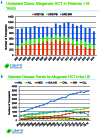History of hematopoietic cell transplantation: challenges and progress
- PMID: 33054108
- PMCID: PMC7716373
- DOI: 10.3324/haematol.2019.245688
History of hematopoietic cell transplantation: challenges and progress
Abstract
After more than 60 years of research in allogeneic hematopoietic cell transplantation (HCT), this therapy has advanced from one that was declared dead in the 1960s to a standard treatment of otherwise fatal malignant and non-malignant blood diseases. To date, close to 1.5 million hematopoietic cell transplants have been performed in more than 1,500 transplantation centers worldwide. This review will highlight the enormous efforts by numerous investigators throughout the world who have brought the experimental field of HCT to clinical reality, examine ongoing challenges, and provide insights for the future.
Figures


References
-
- Jacobson LO, Simmons EL, Marks EK, Robson MJ, Bethard WF, Gaston EO. The role of the spleen in radiation injury and recovery. J Lab Clin Med. 1950;35(5):746-770. - PubMed
-
- Jacobson LO, Marks EK, Robson MJ, Gaston EO, Zirkle RE. Effect of spleen protection on mortality following x-irradiation. J Lab Clin Med. 1949;34:1538-1543.
-
- Lorenz E, Uphoff D, Reid TR, Shelton E. Modification of irradiation injury in mice and guinea pigs by bone marrow injections. J Natl Cancer Inst. 1951;12(1):197-201. - PubMed
-
- Jacobson LO. Evidence for a humoral factor (or factors) concerned in recovery from radiation injury: a review. Cancer Res. 1952;12(5):315-325. - PubMed
-
- Barnes DWH, Loutit JF. What is the recovery factor in spleen? Nucleonics. 1954;12(5):68-71.
Publication types
MeSH terms
Grants and funding
LinkOut - more resources
Full Text Sources
Other Literature Sources

